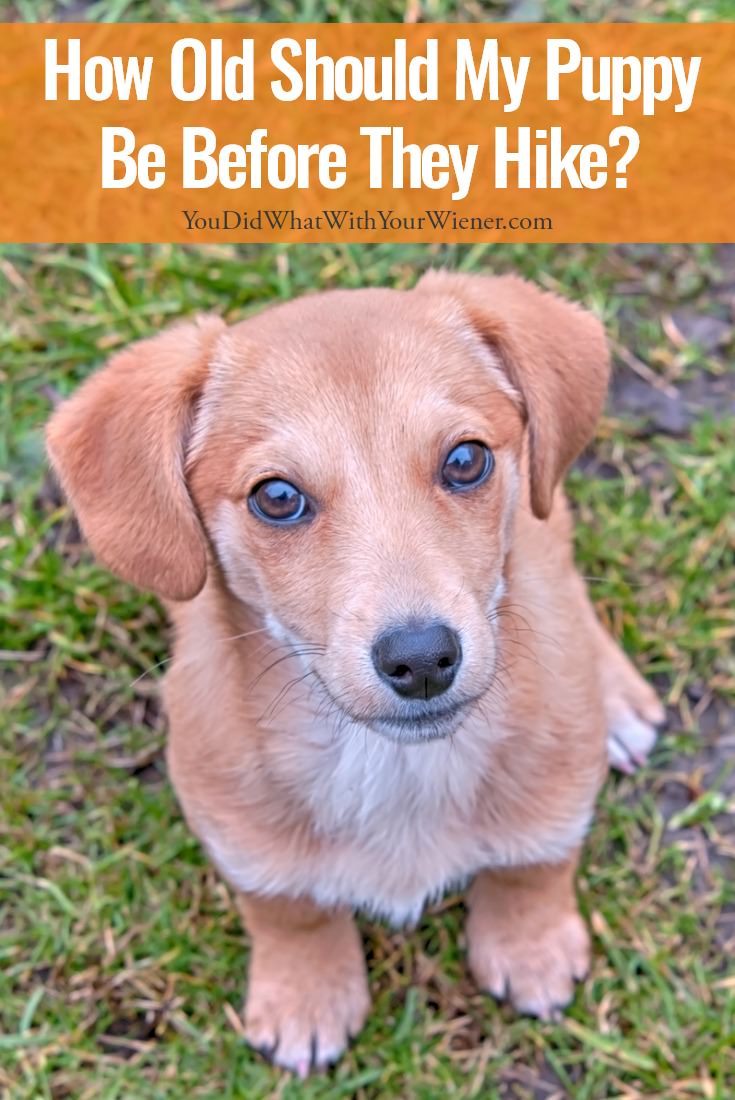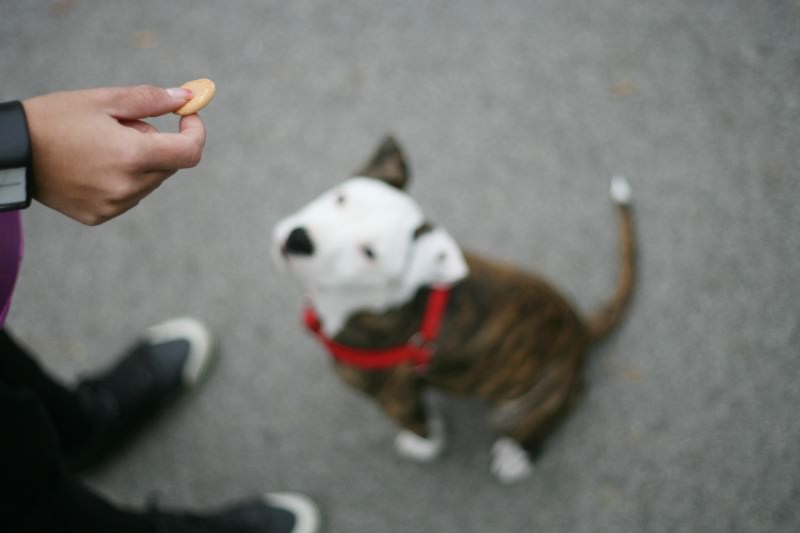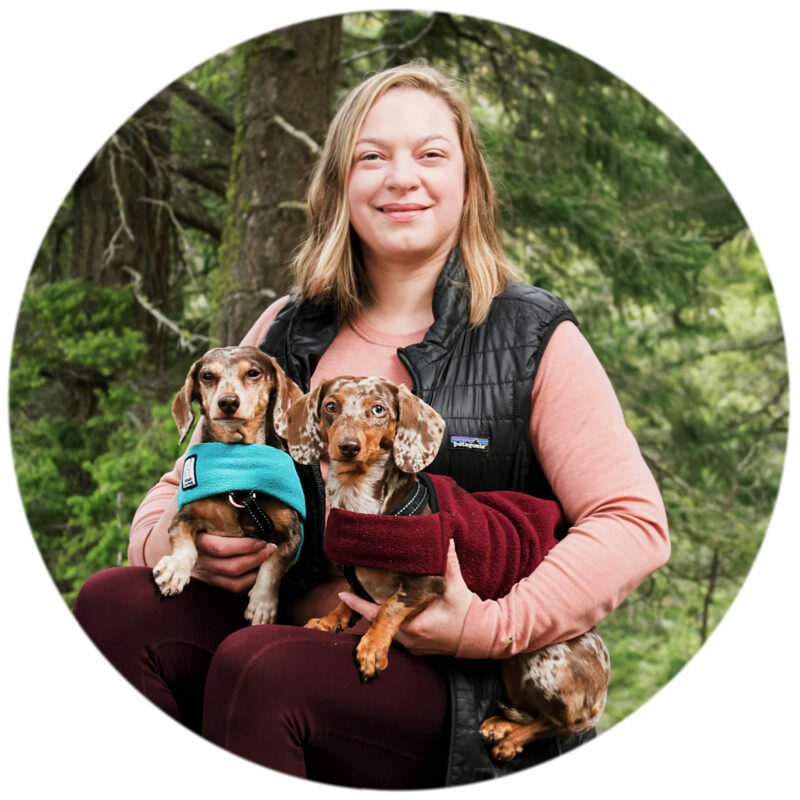How Old Should My Puppy Be Before They Hike?
You wanted a hiking buddy with lots of energy and that was always excited to go when you are so you got a puppy.
You can’t wait to hit the trails with your new pup and introduce them to a life of adventure.
But should you?
UPDATED: November 4, 2022
Puppies shouldn’t go on substantial hikes until their bodies have fully matured.
This article is about hiking with your puppy but the same information applies whether you want to go on long walks with your puppy, running with your puppy, or have your puppy participate in any kind of physical exercise.

So how old should your puppy be before they start hiking?
At What Age is it Safe for Puppies to Hike?
Your young, sprightly pup is full of energy, and sure to be your closest adventure buddy in years to come.
But don’t head to the trails just yet – long and steep hikes are generally not suitable for young puppies.
You need to take into consideration your pup’s age, size, breed and health before you start going on those big adventures.
In your pup’s first year of life, their limbs will grow longer. While your pup is still growing, they’re at risk for growth plate injuries.
Growth plates are soft regions at the end of your pup’s bones that harden as they finish growing. These growth plates are vulnerable to damage from over-exercise and trauma.
The exact age at which your dog is ready for intense hikes will vary.
Growth plate injuries that occur before your pup is eight months old tend to be the most devastating, and may result in deformities that require surgery.
Dogs are vulnerable as long as they are still growing, which can be one year old for small dogs, and 18 months for large dogs.
It’s best to ask for your veterinarian’s professional opinion on when your puppy is ready to hike.
What You Should Know About Growth Plate Injuries
Growth plate injuries can be acute – caused by some kind of trauma – while chronic injuries are caused by long-term strain on the joints.
Besides hiking, they can also suffer growth plate injuries from normal activities like playing, going up or down stairs, and jumping off furniture.
Signs of bone growth plate injuries include swelling, pain, limping, stiffness and abnormal growth. These are good to know even if you don’t take your puppy on long hikes.
You’ll need to see your vet about any mild symptoms that last longer than a few hours, or immediately in cases of trauma or severe pain.
The 5-Minute Rule For Puppy Exercise
The general rule for puppy exercise is 5 minutes of walking per month of age up to twice a day.
So, for example, a 4 month old puppy could walk up to 20 minutes twice a day.
It is important to know that this is a conservative guideline.
There is much debate in the animal orthopedics world about this rule with some saying the rule should be adhered to and others saying that a puppy can safely exercise as long as they want if the exercise is self limited.
In other words, some think that a puppy exceeding this time constraint if they are enjoying themselves, showing no signs of being tired or injured, and are not being “forced” to do more than they would on their own accord, is acceptable.
The issue lies with that last point – being “forced” to exercise more than they would on their own.
The term forced makes it sound harsh but “forced” can mean things like:
- Thinking a puppy is stopping out of stubbornness and encouraging them to go on anyway
- Fence-running, agility, and even playing with older/larger dogs can be considered “forced exercise” because your puppy may overexert itself trying to keep up.
- Similarly, your puppy being tired and sore but keeping up with you on the trail because they want to please you more than they want to stop
- Missing the body language and behavior signs that your puppy has exercised too much that day – because they are new to you and you don’t know the signs yet – and not making them stop
The takeaway is to start with the 5-minute rule but it may be ok for your puppy to exercise a little longer if they are doing it completely of their own will and now showing any signs of being tired or injured.
Remember That Hiking is Much Harder Than Walking in the Park for Your Puppy
I know most people who hike are itching to take their puppies out on the trail right away.
A few laps around your local park, or a brief walk in a wooded area, can be good ways to introduce your puppy to the concept of hiking without much risk.
However, going on a 5+ mile hike over rough terrtain can be more difficult for a puppy so you may want to cut the 5-minute “time rule” above in 3/4 or 1/2.
In other words, that same 4 month old puppy would start out with only 10-15 minutes of hiking on a trail.
Avoid difficult terrains, and lift your puppy in and out of the car (don’t let them jump out on their own).
As your puppy approaches a year of age, you can begin taking them on shorter “real hikes”.
The general time limit still applies but the older your puppy, the further you can go.
A 12 month old puppy can hike around 60 minutes at a time, which is usually enough to cover 2-3 miles.
Take frequent breaks, even if your dog doesn’t seem tired, and look for signs that they’ve hiked too far – but aim to stop long before that point.
Be aware that you don’t only have to worry about growth plate injuries.
Overexertion, dehydration, heat stroke and muscle tears are all possible side effects of hiking, especially if you don’t gradually work your way up to long hikes in rough terrain.
In The Meantime, Prepare for Hiking by Training Your Pup
While your pup is still growing, you can focus on training so they’ll be well mannered for their first hike as a grown dog.
This will give YOU something to focus on too so you aren’t tempted to push them too far too fast.

Essential training skills your pup should know before hiking include:
Walking on a loose leash
An excited young dog can spoil a hike by constantly pulling ahead.
Start in a low-distraction environment like your backyard, and focus on getting your dog to walk by your side.
You can use the Silky Leash Method, stopping when your dog pulls, then rewarding them when they leave slack on the leash by giving them a treat or picking up the speed.
Not grabbing everything they find
There’s lots of cool finds on hiking trails – sticks, leaves, abandoned snack food, poop, dead animals – some of which can make your dog sick if they’re not trained to leave it.
A strong recall
It’s safest to keep your dog on a 6-foot leash when hiking (and required on many trails).
However, your dog, for various reasons may not always be attached to you.
They can slip out of their harness. The leash could break. Or, you may even eventually want to allow your dog off-leash in safe areas where dogs are permitted to be loose.
In the meantime, practice recall every day until your dog responds to your whistle or call, even in high-distraction areas.
Politely greeting other dogs
It’s not necessary to let your dog say hello to every other dog you see on the trail.
But you’re inevitably going to run into off-leash dogs, so it’s good to socialize your puppy so they’re comfortable with random greetings.
When your dog is on leash but the other dog is not, it can be stressful because your dog has no choice but to have another dog in their face.
Keep meetings brief and attempt to keep your dog’s focus on you. It’s more important to be comfortable than for them to learn they must tolerate situations that stress them out.
If you have a little patience, and focus on light exercise and training while they are still a puppy, you’ll have a fit and well mannered trail dog in no time.

About the Author
Hi, I’m Jessica. I’ve been studying the Dachshund breed since 2007, owned 3 of my own, and shared in the lives of thousands of others through their owner’s stories. When I’m not sharing what I know on this blog, you can find me hiking, camping, and traveling with my adventurous wiener dogs.

Another great post! So many new puppy owners are just not aware of the danger! And for some reason veterinarians typically don’t caution new puppy owners about growth plate injuries. I’ve always wondered why this possibility is never mentioned during puppy visits
The reason they don’t mention it is that there is no evidence it’s true!
This weekend gone I took my pup out for his first hike (and mine, too…) and he handled it really well. Most of the climb he spent rummaging around around like a little mountain goat. Some great tips here to get your pup ready for this first and many more hikes.
Thank you for the link! We currently live in Michigan, so when I say hike, I really mean a stroll through the woods. There is no elevation here ?
We do need to work more on leave it. Bo’s favorite part of hiking is to eat All. The. Sticks.
Off to read more of your posts!
This is a great post. My parents recently adopted a new pup and we were just taking about this the other day. We have done several short hikes on easy terrain already, but are leaving the long hikes until she is a little older. Thanks for the good information.
Excellent article!
Kala and I are avid hikers but we eased into it once she reached maturity. Even after all this time and loads of experience I take great care that she gets lots of rest and “pit stops” along the way, and that we have all the necessary equipment for anything that may befall us on the trail.
I absolutelly agree that these kinds of activities aren’t healthy for your puppy and his/hers still developing body no matter how light the chosen trail seems to you. Be patient and work on your socialization and obedience skills as a necessary foundation for the good times to come.
Thank you for bringing this up! Even the old rule of five minutes per month of age is no longer accepted. Puppies need to play in “bursts” which is not hiking or even walking. Better to wait than risk permanent damage!
I have never heard about not taking my dogs on longer hikes! How come the breeder did not mention it?
I hiked with my dogs form an early age and they turned out fine….
Hi Angie. I can’t say why your breeder didn’t mention it. Perhaps she didn’t know you were an avid hiker? Perhaps, and I don’t mean this in an insulting way, but the breeder doesn’t actually know about the issue? It’s true that many dogs can start strenuous activity at a young age and be “fine” but not fine typically means that they develop arthritis, have orthopedic injuries, etc. Those things can happen to any dog but it’s possible, with one that has done too much exercise too soon, that they have more issues with these things or develop things like arthritis sooner than they normally would have. Of course, there is no noticeable detrimental effect for some dogs. It’s a precaution and something that any current, knowledgeable vet will tell you (the not exercising too early). Medical science is more advanced now, even for dogs, than it was even 10 years ago. At one time, it wasn’t known that too much exercise too early has the potential do damage a dog for life.
I definitely wouldn’t expect my puppy to really do any of the trail. Would there be any caution to taking a dog backpacking with you if you are carrying them in a pack for the entirety of the trail with exception to breaks to let them out to stretch and camp? Thanks!
I have a 1/2 dashchund 1/2 teddy bear (shi-tzu bichon) and I took my dog on 1 hour 15 min hike , pretty steep the other day and she is 5 months old. She did great!
Now im thinking I shouldn’t do it?!
Correct. CAN and SHOULD are two different things. A dog will push themselves beyond what they should when they are really excited (by smells or whatever) and to keep up with you. They won’t look tired most of the time. But the potential damage is do the joints, ligaments, etc. that you can’t see and may not for years (for example, developing arthritis at an earlier age). Until a puppy is full grown, which is around 12 months for small dogs , they should not exercise more than 5 minutes for every month up to twice a day (they need that break in between). So, at 5 months, the max should be up to 25 minutes twice a day. Now, with that being said, do people do more than recommended with their puppy? Yes, many people don’t know or don’t care. The choice is up to you. It’s about giving them the best chance you can at a long, healthy life.
Do you have any scientific evidence For this 5min per month claim? I cannot find a single paper and top vets in the UK have stated it’s nonsense?
Hi Neil. Great question. Here is a quote from the American Kennel Club that addresses this: “There is a lot of debate in the dog world about puppies and exercise. Veterinarians, breeders, and trainers all seem to agree that too much exercise is just as bad as not enough, but there is no set formula for calculating your puppy’s progress…. Veterinarian Dr. Patty Khuly points out that some of this confusion stems from a combination of a lack of scientific studies and a variety of personal opinions. She compares the debate about puppy exercise to the ongoing debate about exercise, sports, and children – there are many different approaches to exercise, and each has its ups and downs. (source article: https://www.akc.org/expert-advice/health/puppies-how-much-exercise/). The keys here for me are “debate” and “lack of scientific studies” (note: not scientific evidence – a lack of studies doesn’t mean something isn’t true). Many veterinarians in the US do recommend this 5 minute rule as a guideline but it’s my understanding this is just a conservative estimate for a good baseline. In other words, it’s a good estimate of how much vigorous exercise a puppy can do depending on their age but it’s just a place to start. The calculation is something pet owners can easily understand and it helps to reinforce the concept that exercise should be incresed gradually as they grow. I think most US vets would tell you – and it’s also been my experience – that each dog is an individual and, while the 5 minute rule is a good guideline, as long as one is paying attention to how their puppy is feeling during and after exercise, this is not a strict time limit. In the case of hiking, which is typically a very rigorous activity for dogs, I think it’s important to start out slow and work a dog’s fitness level up to doing more (that’s really true for a dog of any age if they haven’t done it before).